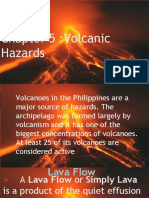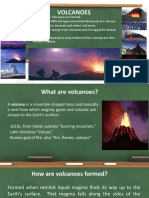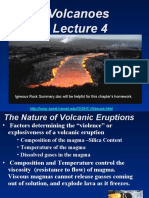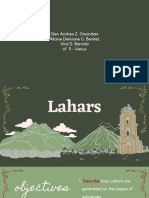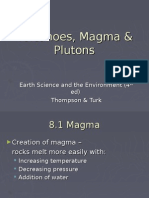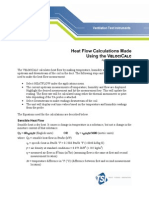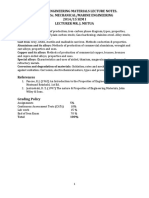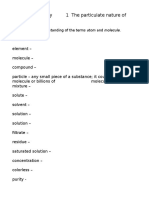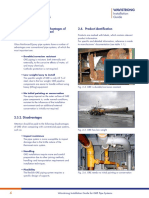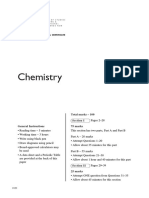0 ratings0% found this document useful (0 votes)
52 viewsLava Flow
Lava Flow
Uploaded by
Kyle Ashley DavinLava flow occurs when molten lava is expelled from an erupting volcano. Lava can flow long distances from the volcano depending on factors like slope and composition. Lava flows are very hot but move slowly, and can cause burns if contacted. The composition of lava determines its behavior and viscosity. There are three main types of lava based on composition - mafic, intermediate, and felsic. Lava flows can have different surface textures including smooth pahoehoe, rough aa, blocky, or pillow shapes underwater.
Copyright:
© All Rights Reserved
Available Formats
Download as PPTX, PDF, TXT or read online from Scribd
Lava Flow
Lava Flow
Uploaded by
Kyle Ashley Davin0 ratings0% found this document useful (0 votes)
52 views15 pagesLava flow occurs when molten lava is expelled from an erupting volcano. Lava can flow long distances from the volcano depending on factors like slope and composition. Lava flows are very hot but move slowly, and can cause burns if contacted. The composition of lava determines its behavior and viscosity. There are three main types of lava based on composition - mafic, intermediate, and felsic. Lava flows can have different surface textures including smooth pahoehoe, rough aa, blocky, or pillow shapes underwater.
Original Title
LAVA FLOW
Copyright
© © All Rights Reserved
Available Formats
PPTX, PDF, TXT or read online from Scribd
Share this document
Did you find this document useful?
Is this content inappropriate?
Lava flow occurs when molten lava is expelled from an erupting volcano. Lava can flow long distances from the volcano depending on factors like slope and composition. Lava flows are very hot but move slowly, and can cause burns if contacted. The composition of lava determines its behavior and viscosity. There are three main types of lava based on composition - mafic, intermediate, and felsic. Lava flows can have different surface textures including smooth pahoehoe, rough aa, blocky, or pillow shapes underwater.
Copyright:
© All Rights Reserved
Available Formats
Download as PPTX, PDF, TXT or read online from Scribd
Download as pptx, pdf, or txt
0 ratings0% found this document useful (0 votes)
52 views15 pagesLava Flow
Lava Flow
Uploaded by
Kyle Ashley DavinLava flow occurs when molten lava is expelled from an erupting volcano. Lava can flow long distances from the volcano depending on factors like slope and composition. Lava flows are very hot but move slowly, and can cause burns if contacted. The composition of lava determines its behavior and viscosity. There are three main types of lava based on composition - mafic, intermediate, and felsic. Lava flows can have different surface textures including smooth pahoehoe, rough aa, blocky, or pillow shapes underwater.
Copyright:
© All Rights Reserved
Available Formats
Download as PPTX, PDF, TXT or read online from Scribd
Download as pptx, pdf, or txt
You are on page 1of 15
LAVA FLOW
What is lava flow?
• Lava is the red hot molten rocks or magma that is expelled out of an
erupting volcano. Lava when inside the earth’s crust is reffered to as
magma. The temparature of lava is over 2000 degrees Fahrenheit. The lava
stays in the molten form and flows to the ground from the volcano. Once it
cools it becomes hard and a forms a rock.The lava expelled from a volcano is
vicous . It has 100,000 times more viscosity than water.
• The lava flows from the volcano in either a molten or semi-molten form. The
distance that lava flows depends on several factors like the extrusion rate,
the temperature of the flow, land slope, and silica content. Lava flows are not
very fast. However , they are ver hot and can cause burns, charring, and
injuries to humans if they get closer. Lava takes several days to years to
completely down.
Effects of lava flow
• Everything in the path of an
advancing lava flow will be knocked
over, sorrounded, buried, or ignited
by the extremely hot temperature of
lava.
Lava Composition
• Lava is majorly made of melted rocks, dissolved gas, and crystals. The core
of the Earth contains magma which is dissolved in liquid. However, when the
magma erupts from the volcano the gas forms a distinct vapor phase as the
pressure is released. The gas present in the magma is the cause of its
explosive nature. The lava generally contains carbon dioxide, chlorine, sulfur,
and fluorine gases.
• The composition of lava also determines its behavior. The igneous rocks
formed from the cool lava are categorized into three types based on their
chemical composition. These groups have different amounts of elements and
viscosity.
• Felsic Lava
• Intermediate Lava
• Mafic Lava
Mafic Lava
• The word derives from a composite of the chemical symbols for Magnesium
(Ma) and Iron (Fe). This magma has a low viscosity, which allows for gases
to escape the volcano, and for the lava flows to erupt calmly and predictably.
• Describes magma that contains lower amounts of silica and is generally less
viscous and less gas-rich than silicic magma. Tends to erupt effusively, as
lava flows.
Intermediate Lava
• As the name suggests, intermediate lava has a mineral composition that falls
between mafic and felsic lavas. It is also known as andesitic lava. It has low
amounts of silica and aluminum and high amounts of iron and magnesium
compared to felsic lava. This type of lava also erupts at temperatures around
750-950 degrees C. Intermediate lava forms blocky lava morphologies.
Felsic lavas
• are low temperature lavas because lower temperatures are required to keep
felsic minerals molten (and if it was hotter it would have incorporated more
iron and magnesium in comparison to silica). So, mafic lavas are hot , low in
silica and volatiles, and have relatively low viscosity.
Types of Lava Flows
Pahoehoe lava
Pahoehoe is a smooth and continuous lava crust. Pahoehoe forms when the
effusion rate is low and consequently the velocity of lava flow is slow2.
Pahoehoe lava flow is usually at least 10 times slower than typical aa lava
flow5. Higher effusion rate results in lava flow being shattered which is how the
rubbly and clinkery aa lava surface forms.
Forming basaltic pahoehoe
lava flow in Hawaii. Such
lava flows move slowly and
are not overly dangerous when
compared with some other
volcanic phenomena.
Aa lava
• Aa lava is a rough rubbly crust of a lava flow. It is a major lava
flow type. Other important subaerial lava flow types are pahoehoe
and blocky lava.
• Aa and pahoehoe are terms that were brought to geological
terminology from the Hawaiian language. Aa is according to native
Hawaiians a sound one makes if he or she tries to walk barefoot
on such a lava flow. There are different spelling versions, ‘a’a, a’a,
a-aa are used as well as simple aa. Pahoehoe means in Hawaiian
“on which one can walk”
Pahoehoe lava flow in the
center that have partially
covered the aa-type flow in
Hawaii.
Aa lava on the floor of the Las
Cañadas caldera in Tenerife,
Canary Islands
Blocky lava
• Blocky flows are common if the silica content of lavas is higher
(composition of basaltic andesite to rhyolite).
• Blocky lava flows resemble aa lavas. They also have highly
irregular surfaces covered with debris, but they contain larger lava
blocks with smoother sides and angular edges with common
dimensions from few decimeters to several meters. Blocky flows
grow higher as they advance and may reach more than 100
meters in height.
Here is a blocky flow (formed
in 1712) from La Palma,
Canary Islands. Blocks are
angular and have much
smoother sides than separate
pieces of aa lava.
Pillow lava
• Pillow lava is usually basaltic or andesitic in composition and
always associated with water. Pillows are about one meter across
each or smaller and form when lava flows out of the Earth’s crust
underwater. Each pillow is like a bag that has quickly chilled
margin which is filled with molten material. Pillow lavas are usually
associated with mid-ocean ridge volcanism. The upper part of the
oceanic crust is composed of countless number of lava pillows,
but they can also form in much shallower conditions, even in lakes
or under glacial ice.
Pillow lava in the Caldera de
Taburiente, La Palma, Canary
Islands.
You might also like
- Isotope BrochureDocument1 pageIsotope BrochureFaith A. DoradoNo ratings yet
- 2019-12-20 Reboiler - Spec. SheetDocument1 page2019-12-20 Reboiler - Spec. SheetVasiljka Đordan JelacaNo ratings yet
- Document 1Document1 pageDocument 1Shakira Mhaire Mananquil AguirreNo ratings yet
- LavaDocument2 pagesLavaHasan BukhoriNo ratings yet
- Lava Flow DRRMDocument26 pagesLava Flow DRRMCyannah EcrivaineNo ratings yet
- Chapter 5 Group 1 ReportDocument92 pagesChapter 5 Group 1 ReportAxel ElisonNo ratings yet
- Volcanism and MagmatismDocument60 pagesVolcanism and Magmatismnatoyman1415No ratings yet
- Science 9 15.5 Materials Emitted From Volcanic EruptionsDocument31 pagesScience 9 15.5 Materials Emitted From Volcanic EruptionsjodelynNo ratings yet
- Volcanic HazardsDocument161 pagesVolcanic HazardsMichelle Calera Bocboc100% (1)
- Parts of A VolcanoDocument23 pagesParts of A VolcanoMaricel EspirituNo ratings yet
- Lava FlowDocument10 pagesLava Flowducusincrissa42No ratings yet
- 4qdr3l2partsofavolcano 210310034653Document23 pages4qdr3l2partsofavolcano 210310034653JuLie Ann DeGuzman GeslaniNo ratings yet
- DRRRDocument40 pagesDRRRJuliana AdvinculaNo ratings yet
- Ol.6: Volcanoes and Volcanic HazardsDocument29 pagesOl.6: Volcanoes and Volcanic HazardsSalman Bin TariqNo ratings yet
- Viscosity DiscussionDocument6 pagesViscosity DiscussionGerald LegesnianaNo ratings yet
- Types of RockDocument21 pagesTypes of RockLhem YenniavNo ratings yet
- DRRR FinalsDocument4 pagesDRRR Finalsramosmathew1124No ratings yet
- Hand Out Volcano HazardsDocument9 pagesHand Out Volcano HazardsKen WalkerNo ratings yet
- CabrerosDocument15 pagesCabrerosJanskie BulabogNo ratings yet
- Volcanoes and Volcanic EruptionsDocument20 pagesVolcanoes and Volcanic Eruptionssuren kambleNo ratings yet
- OEC 3.4 Lava FlowsDocument2 pagesOEC 3.4 Lava FlowsRajguru PatilNo ratings yet
- VOLCANOESDocument65 pagesVOLCANOESPrincess Alyssa BarawidNo ratings yet
- Volcanoes g9Document33 pagesVolcanoes g9rvnsj28No ratings yet
- Types of Volcano 4Document25 pagesTypes of Volcano 4Jaypee CarlNo ratings yet
- Lava Flow: Baculao Buca DabloDocument12 pagesLava Flow: Baculao Buca DabloLol lolNo ratings yet
- Geology Lesson 1 4Document29 pagesGeology Lesson 1 4lorlynvillareal.20No ratings yet
- ME Sci 9 Q3 1204 PSDocument34 pagesME Sci 9 Q3 1204 PSACAD COOR SCIENCENo ratings yet
- Erupted Material: Volcanic GasesDocument3 pagesErupted Material: Volcanic GasesNaditaNo ratings yet
- ERUPTIONDocument3 pagesERUPTIONFerland James DelMar GumahinNo ratings yet
- Volcanoes-How It Is FormedDocument55 pagesVolcanoes-How It Is FormedHenry JacobNo ratings yet
- Extrusive Volcanic Landforms Inc - MontDocument43 pagesExtrusive Volcanic Landforms Inc - MontnyumudimitriNo ratings yet
- VolcanismDocument97 pagesVolcanismKristina ShirleyNo ratings yet
- Volcanoes RevisionDocument15 pagesVolcanoes Revision3alliumcourtNo ratings yet
- Lecture 04 Volcanic Activity GDocument65 pagesLecture 04 Volcanic Activity GMarianne B. HingpesNo ratings yet
- What Is Volcanism?Document49 pagesWhat Is Volcanism?Claire LouisNo ratings yet
- 5.lahars VenusDocument24 pages5.lahars VenusFhia Angelika IntongNo ratings yet
- What Comes Out of A VolcanoDocument14 pagesWhat Comes Out of A VolcanoShiro NeroNo ratings yet
- Volcanoes: Grade 9, Module 3 Lesson 1.1Document36 pagesVolcanoes: Grade 9, Module 3 Lesson 1.1precious maningasNo ratings yet
- VolcanoesDocument75 pagesVolcanoesMeleen ConstantinoNo ratings yet
- Magmatic Eruptions: HawaiianDocument2 pagesMagmatic Eruptions: HawaiianJoy ABNo ratings yet
- Lec 7&8 VolcanoesDocument62 pagesLec 7&8 Volcanoesprasanthziggler88No ratings yet
- Volcanoes, Magma & PlutonsDocument37 pagesVolcanoes, Magma & Plutonswonder-chef-4677100% (1)
- LEGENDS OF HAWAIIAN VOLCANOES - 20 Legends about Hawaii's VolcanoesFrom EverandLEGENDS OF HAWAIIAN VOLCANOES - 20 Legends about Hawaii's VolcanoesNo ratings yet
- VolDocument7 pagesVoltristanredondo050309No ratings yet
- VolcanoesDocument10 pagesVolcanoesShazira AllyNo ratings yet
- VOLCANOESDocument37 pagesVOLCANOESrichele rectoNo ratings yet
- Lahar M.mendozaDocument8 pagesLahar M.mendozaitsmebayyangNo ratings yet
- Volcanoes NotesDocument2 pagesVolcanoes Notesapi-235019933No ratings yet
- VolcanoesDocument36 pagesVolcanoesjhoms8No ratings yet
- Science 9 Group II Silica ContentDocument11 pagesScience 9 Group II Silica ContentreganthiaNo ratings yet
- Classifications of VolcanoDocument53 pagesClassifications of VolcanoAthena Bermundo100% (3)
- Volcanoes and EarthquakesDocument17 pagesVolcanoes and Earthquakesruv.asn17No ratings yet
- Volcanoes and Viscosity BSU (4-6)Document14 pagesVolcanoes and Viscosity BSU (4-6)rudeNo ratings yet
- Earth Science Midterm Lesson 2-2022Document44 pagesEarth Science Midterm Lesson 2-2022April Rose MarasiganNo ratings yet
- Volcano PPTDocument54 pagesVolcano PPTjocelyn.matigaNo ratings yet
- 04 Hawaii VolcanoesDocument26 pages04 Hawaii VolcanoesJobanie AmadhayNo ratings yet
- What Is Basaltic Lava?Document3 pagesWhat Is Basaltic Lava?earlNo ratings yet
- Hawaiian Legends of Volcanoes (mythology): Collected and translated from the HawaiianFrom EverandHawaiian Legends of Volcanoes (mythology): Collected and translated from the HawaiianNo ratings yet
- Lecture 5 - VolcanoesDocument45 pagesLecture 5 - VolcanoesDaniel MogorosiNo ratings yet
- Types of VolcanoesDocument6 pagesTypes of VolcanoesCheska Reese Tan SilvaNo ratings yet
- VolcanoesDocument42 pagesVolcanoesapi-277897156100% (1)
- Chapter 4 Part 1 Reactions in Aqueous SolutionDocument24 pagesChapter 4 Part 1 Reactions in Aqueous SolutionrehmaNo ratings yet
- Dosh Q & A: Hard SurfaceDocument2 pagesDosh Q & A: Hard SurfaceZain SallehNo ratings yet
- VTI OF Seal-Lock XP and XP-PCDocument3 pagesVTI OF Seal-Lock XP and XP-PCCong BuiNo ratings yet
- Various Factor Affecting Stability of FormulationDocument46 pagesVarious Factor Affecting Stability of FormulationSandip Prajapati100% (1)
- Heat Flow Calculations Made Using The V C: Ventilation Test InstrumentsDocument6 pagesHeat Flow Calculations Made Using The V C: Ventilation Test Instrumentsretrospect1000No ratings yet
- 34 CR Mo 4Document2 pages34 CR Mo 4fsfunbNo ratings yet
- Atp Star 3Document8 pagesAtp Star 3Gowri ShankarNo ratings yet
- STP-Ph1-JWWF-P05-00 - 0002 - 2 NATIVE FILEDocument104 pagesSTP-Ph1-JWWF-P05-00 - 0002 - 2 NATIVE FILEFaisal MumtazNo ratings yet
- Bitustick XLS HynkleDocument2 pagesBitustick XLS HynkleMohamed ShehataNo ratings yet
- Mediapedia Colored Pencil PDFDocument4 pagesMediapedia Colored Pencil PDFJoe Dickson67% (3)
- Emg 2201 Engineerinr Materials Lecture NotesDocument18 pagesEmg 2201 Engineerinr Materials Lecture NotesAbdul jeleelNo ratings yet
- Notes The Particulate Nature of MatterDocument5 pagesNotes The Particulate Nature of MatterMihika ShethNo ratings yet
- Weaving WasteDocument13 pagesWeaving WasteShreya parasharNo ratings yet
- Wavistrong Installation Guide - Part10Document1 pageWavistrong Installation Guide - Part10gfhf dgdNo ratings yet
- Internal Epoxy Coating in Surface CondenserDocument14 pagesInternal Epoxy Coating in Surface CondenserChaudhari SanketNo ratings yet
- Problem Set 2 - Shear StressDocument2 pagesProblem Set 2 - Shear Stressmanacc.travisNo ratings yet
- North Star Water Softener ManualDocument28 pagesNorth Star Water Softener ManualAnonymous l2sT4aENo ratings yet
- IV EQR2016 PDFDocument36 pagesIV EQR2016 PDFAnis Najihah100% (1)
- S O S Services Alert Level Help SheetDocument20 pagesS O S Services Alert Level Help Sheetjizu100% (2)
- AEM 综述Toward Wafer‐Scale Production of 2D Transition Metal ChalcogenidesDocument24 pagesAEM 综述Toward Wafer‐Scale Production of 2D Transition Metal ChalcogenidesP WangNo ratings yet
- Cement - Superplasticizer CompatibilityDocument8 pagesCement - Superplasticizer CompatibilitySumit SrivastavaNo ratings yet
- Certificados - Mtc-Po 23040-Req 14989Document98 pagesCertificados - Mtc-Po 23040-Req 14989MissionPetroleum InfoNo ratings yet
- Water Analysis Journal (Group5) PDFDocument7 pagesWater Analysis Journal (Group5) PDFDominic CareoNo ratings yet
- 2015 HSC Chemistry PDFDocument42 pages2015 HSC Chemistry PDFlillianaNo ratings yet
- GPC Valenzuela TP-1Document1 pageGPC Valenzuela TP-1Joshua John Lopez JulioNo ratings yet
- Two On A Follow: A Olution 1 GM: So I S S S S S)Document6 pagesTwo On A Follow: A Olution 1 GM: So I S S S S S)Mohit SharmaNo ratings yet
- A PROJECT On g+5 Buildings-EngineeringcivilDocument37 pagesA PROJECT On g+5 Buildings-EngineeringcivilAnil Sukhani40% (5)
- Brokers Recyclers 2023Document12 pagesBrokers Recyclers 2023CM DubeyNo ratings yet




